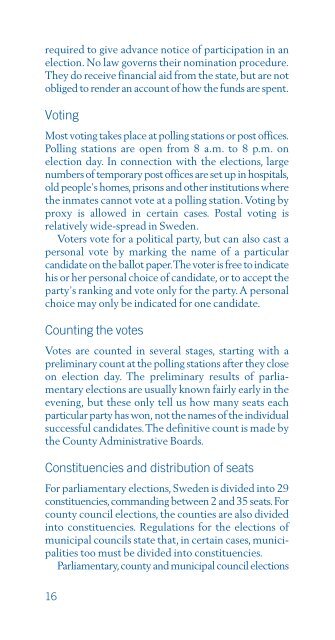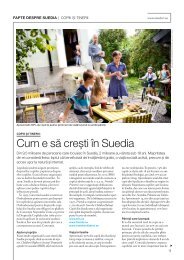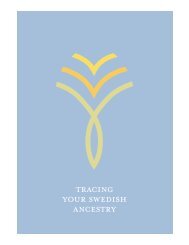Election Guide 2002 - Sweden.se
Election Guide 2002 - Sweden.se
Election Guide 2002 - Sweden.se
You also want an ePaper? Increase the reach of your titles
YUMPU automatically turns print PDFs into web optimized ePapers that Google loves.
equired to give advance notice of participation in an<br />
election. No law governs their nomination procedure.<br />
They do receive financial aid from the state, but are not<br />
obliged to render an account of how the funds are spent.<br />
Voting<br />
Most voting takes place at polling stations or post offices.<br />
Polling stations are open from 8 a.m. to 8 p.m. on<br />
election day. In connection with the elections, large<br />
numbers of temporary post offices are <strong>se</strong>t up in hospitals,<br />
old people’s homes, prisons and other institutions where<br />
the inmates cannot vote at a polling station. Voting by<br />
proxy is allowed in certain ca<strong>se</strong>s. Postal voting is<br />
relatively wide-spread in <strong>Sweden</strong>.<br />
Voters vote for a political party, but can also cast a<br />
personal vote by marking the name of a particular<br />
candidate on the ballot paper. The voter is free to indicate<br />
his or her personal choice of candidate, or to accept the<br />
party’s ranking and vote only for the party. A personal<br />
choice may only be indicated for one candidate.<br />
Counting the votes<br />
Votes are counted in <strong>se</strong>veral stages, starting with a<br />
preliminary count at the polling stations after they clo<strong>se</strong><br />
on election day. The preliminary results of parliamentary<br />
elections are usually known fairly early in the<br />
evening, but the<strong>se</strong> only tell us how many <strong>se</strong>ats each<br />
particular party has won, not the names of the individual<br />
successful candidates. The definitive count is made by<br />
the County Administrative Boards.<br />
Constituencies and distribution of <strong>se</strong>ats<br />
For parliamentary elections, <strong>Sweden</strong> is divided into 29<br />
constituencies, commanding between 2 and 35 <strong>se</strong>ats. For<br />
county council elections, the counties are also divided<br />
into constituencies. Regulations for the elections of<br />
municipal councils state that, in certain ca<strong>se</strong>s, municipalities<br />
too must be divided into constituencies.<br />
Parliamentary, county and municipal council elections<br />
16












